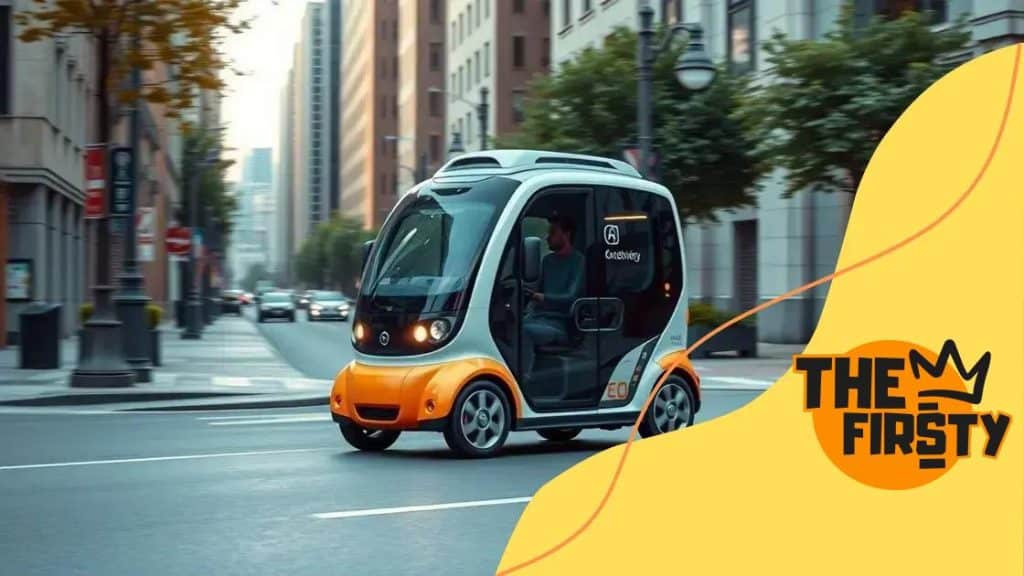How autonomous vehicles will change the future of logistics

Anúncios
Autonomous vehicles will significantly change the future of logistics by enhancing efficiency, reducing costs, improving safety, and promoting sustainability through advanced technologies and automation.
How autonomous vehicles will change the future of logistics gains attention as industry leaders adapt to the rise of this technology. Have you ever imagined a world where goods are delivered without human drivers? Let’s dive into how this shift could transform logistics.
Anúncios
The impact of autonomous vehicles on delivery services
The rise of autonomous vehicles is set to have a significant impact on delivery services. These vehicles are changing how goods reach consumers and businesses, providing faster and more efficient solutions. Imagine packages delivered right to your door by vehicles that drive themselves. This innovation promises to streamline logistics and enhance the customer experience.
Increased Efficiency
Autonomous vehicles can operate around the clock without needing rest, unlike human drivers. This round-the-clock functionality significantly boosts delivery efficiency. Moreover, these vehicles can optimize their routes in real-time using advanced algorithms. This means timely deliveries, reducing delays caused by traffic or weather.
- Faster deliveries through automated route planning.
- Less time spent on loading and unloading due to smart technology.
- Consistent delivery schedules leading to higher customer satisfaction.
As businesses adopt these technologies, we can also expect cost savings on labor and fuel expenses. With fewer drivers needed, businesses can reallocate resources to other important areas. This shift could even translate into lower prices for consumers, making products more accessible.
Anúncios
Safety Improvements
Another key advantage of autonomous vehicles in delivery services is the potential for enhanced safety. These vehicles are designed with state-of-the-art sensors and AI systems that can react faster than human drivers. This technology minimizes the risk of accidents caused by fatigue or distractions.
Moreover, the data collected from these vehicles can be used to improve traffic patterns and road safety measures, benefiting everyone. As autonomous technology matures, we may witness consistently safer streets for all road users.
In summary, the impact of autonomous vehicles on delivery services is profound. With improvements in efficiency, cost savings, and safety, this technology stands to revolutionize how we receive goods. As society adapts to these innovations, we can look forward to a new era in logistics.
Cost savings through automation in logistics
Cost savings through automation in logistics is a driving force behind many companies adopting new technologies. As automated systems like autonomous vehicles and drones become more prevalent, businesses can expect significant reductions in operational costs. This evolution promises to reshape how logistics functions on a global scale.
Reducing Labor Costs
One of the most significant ways automation saves money is by reducing labor costs. With fewer human drivers needed, companies can cut down on payroll expenses and allocate those funds elsewhere. Additionally, automated systems can work longer hours without breaks, maximizing efficiency.
- Fewer employees needed for delivery operations.
- Reduced overtime expenses due to continuous operation.
- Opportunity to invest savings into technology upgrades.
Moreover, the integration of robotics and AI in sorting and warehousing can further streamline processes. By automating these repetitive tasks, companies can enhance productivity while maintaining accuracy, mitigating the risk of human error that often results in costly mistakes.
Efficiency in Resource Management
Automation also drives efficiency in resource management. With advanced data analytics, businesses can predict demand, manage inventory levels, and plan routes more effectively. This optimization reduces waste and ensures that resources are used wisely.
For example, automated systems can analyze delivery routes in real-time, identifying the fastest paths and eliminating unnecessary fuel consumption. As a result, companies can cut down on logistics expenses and improve their overall sustainability practices.
As the logistics industry continues to embrace automation, the potential for cost savings expands. By enhancing efficiency and decreasing labor needs, businesses can become more profitable while delivering better services to their customers. The future of logistics is not just about technology; it’s about smart investments in innovations that yield substantial returns.
Safety improvements with autonomous technology

Safety improvements with autonomous technology represent a major advancement in the logistics industry. As companies embrace these innovations, the potential to reduce accidents and enhance operational safety becomes increasingly clear. Imagine a world where delivery vehicles operate without the risk of human error. This vision is becoming a reality thanks to cutting-edge technology.
Advanced Sensor Technology
One key factor in the safety of autonomous vehicles is their advanced sensor systems. These vehicles use a combination of cameras, radar, and lidar to navigate their surroundings. By constantly scanning for obstacles and adjusting their paths, autonomous vehicles can prevent collisions effectively. Real-time data processing enables these vehicles to react much faster than human drivers.
- 360-degree awareness of surroundings.
- Immediate response to potential hazards.
- Scheduling maintenance based on usage data.
The integration of such technology significantly reduces the likelihood of accidents. With fewer crashes, businesses not only save on repair costs but also protect their reputation and build trust with customers.
Improving Driver Safety
While autonomous vehicles are certainly safer, they also enhance the safety of human drivers on the road. With fewer human-operated vehicles interacting with the public, there’s a greater chance of reducing traffic incidents. Additionally, logistics companies can deploy autonomous vehicles for longer and more consistent operations while adhering to safety regulations.
These vehicles can operate in challenging conditions such as poor weather or dense traffic. Hence, utilizing autonomous vehicles allows businesses to continue providing reliable and regular deliveries to customers while mitigating safety risks. Furthermore, training programs for human drivers can focus on managing logistics operations rather than navigating through heavy traffic, which can enhance overall safety in the industry.
As more companies implement this technology, the logistics sector will likely witness a marked reduction in accidents. With improved safety measures in place, both logistics providers and their customers can enjoy a more secure experience. The era of autonomous technology is not only about efficiency; it’s also about effectively safeguarding lives and assets.
Challenges in the adoption of autonomous vehicles
Challenges in the adoption of autonomous vehicles pose significant barriers to their widespread implementation in logistics. Although these innovations promise greater efficiency and safety, various factors delay their integration into existing systems. Understanding these challenges is essential for businesses to navigate the changing landscape of logistics.
Regulatory Hurdles
One major challenge is the complex regulatory environment surrounding autonomous vehicles. Governments are still developing laws and guidelines to govern their use. Companies must work closely with regulators to ensure compliance, which can slow down deployment. Legal uncertainties can lead to hesitance in investing in autonomous technologies.
- Compliance with state and federal regulations.
- Need for clear liability laws regarding accidents.
- Variations in rules between different regions.
These regulations must address safety standards and operational criteria. Until clearer guidelines are established, many logistics providers may be reluctant to fully embrace automation.
Technological Limitations
Technological limitations also present significant challenges. Although the technology behind autonomous vehicles has advanced greatly, it still faces obstacles. Issues such as data processing capabilities and the reliability of AI systems can hinder performance, especially in unpredictable environments.
For instance, autonomous vehicles must deal with varying weather conditions, road types, and unexpected obstacles. The technology needs to improve in adapting to these situations to minimize accidents and improve efficiency. Furthermore, the high cost of developing and maintaining these advanced systems can be a barrier for many companies.
Public Perception and Trust
Public perception and trust also play critical roles in the adoption of autonomous vehicles. Many people remain skeptical about the safety and reliability of this technology. Widespread concerns regarding potential job losses for drivers and other affected workers can further complicate acceptance.
Logistics companies must engage in education and outreach to build trust. They can share data and case studies that highlight the safety and efficiency of autonomous systems, aiming to shift public opinion. Furthermore, employee retraining programs can help alleviate the concerns of job displacement.
As the logistics industry continues to explore the potential of autonomous vehicles, addressing these challenges will be essential. By overcoming regulatory, technological, and public perception barriers, businesses can pave the way for a safer and more efficient future in logistics.
Future trends in logistics and transportation
Future trends in logistics and transportation are rapidly evolving as technology advances. The introduction of autonomous vehicles and other innovations is reshaping how goods move from one place to another. These changes promise to make logistics more efficient and accessible for businesses and consumers alike.
Increased Automation
Automation will likely play a significant role in the future of logistics. Businesses are starting to see the benefits of using automated systems for warehousing and delivery. These systems can handle many tasks, which allows workers to focus on more strategic responsibilities. Automated sorting and routing will enhance efficiency and reduce delivery times.
- Robotics in warehouses for picking and packing.
- Self-driving vehicles for last-mile delivery.
- Automated inventory management systems.
As automation expands, companies will be able to meet rising consumer demands with greater ease. This can lead to reduced costs and faster service, benefiting everyone involved.
Sustainability Initiatives
Sustainability is another critical trend shaping the future of logistics. Companies are increasingly looking for ways to reduce their carbon footprints and become eco-friendly. The integration of electric and hybrid vehicles will help lower emissions in transportation.
Logistics firms are also exploring sustainable packaging options. Using biodegradable materials can minimize waste and appeal to environmentally conscious consumers. Investing in green technologies not only improves a company’s image but also paves the way for long-term savings.
Data-Driven Decision Making
Data analytics will continue to influence logistics and transportation significantly. By harnessing big data, companies can gain insights into customer preferences, inventory levels, and delivery performance. This information allows businesses to make smarter decisions and adapt quickly to changing market conditions.
Utilizing data can help businesses optimize their supply chains and enhance customer experiences. Predictive analytics will enable companies to foresee demand patterns and adjust their strategies accordingly. As technology advances, the reliance on data will only grow, transforming how logistics operates.
In summary, the future trends in logistics and transportation point towards a more automated, sustainable, and data-driven industry. Companies that embrace these changes will likely thrive in this evolving landscape, providing better service to their customers while adapting to new market demands.
The future of logistics and transportation is bright, driven by advancements in technology and a focus on sustainability. Companies are increasingly adopting autonomous vehicles, automation, and data analytics to enhance efficiency and safety. These innovations not only reduce operational costs but also help businesses meet the growing demand for faster and more reliable services. As the industry evolves, embracing these trends is essential to thrive in a competitive market. Together, we can expect a safer, greener, and more efficient logistics landscape in the years to come.
FAQ – Frequently Asked Questions about Autonomous Vehicles in Logistics
How can autonomous vehicles improve efficiency in logistics?
Autonomous vehicles operate continuously without breaks, allowing for faster deliveries and optimizing routes in real-time to reduce delays.
What are the main challenges in adopting autonomous vehicles?
Key challenges include regulatory hurdles, technological limitations, public perception, and the need for significant investment.
How do sustainability initiatives affect logistics?
Sustainability initiatives encourage companies to adopt eco-friendly practices, such as using electric vehicles and reducing waste, which can lower costs and improve reputation.
What role does data play in modern logistics?
Data analytics helps businesses gain insights into customer behavior, optimize inventory, and enhance supply chain efficiency, making informed decisions.





